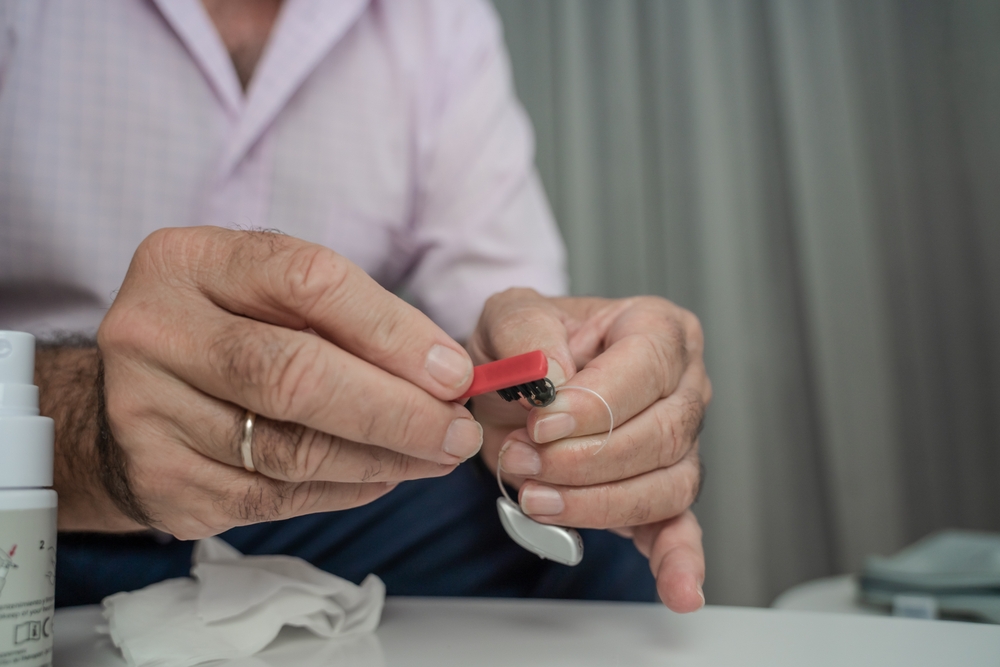
Once you’ve adjusted to life with your hearing aid, it becomes an important part of your daily routine. The prospect of a malfunction can be unsettling, as it poses not only a disturbance to daily life, but also a significant monetary burden in the form of repair or replacement expenses.
How to best maintain your hearing aid
Recognizing what can damage your hearing aid and knowing how to care for it effectively will help you maintain its functionality and ensure it continues to enrich your quality of life.
Practical upkeep of batteries
The effectiveness of your hearing aid relies significantly on its battery. Therefore, picking the appropriate batteries for your hearing aid is crucial. Speak with your hearing specialist to determine the best battery type for your model.
It is equally important to handle the batteries with care. The natural oils, dirt, and moisture on your skin can pass on to the batteries and cause contamination, compromising their performance and potentially causing damage.
Prior to switching out the battery, ensure your hands are clean and thoroughly dry to prevent any moisture from getting into the device.
Stick directly to the manufacturer’s instructions, especially pertaining to battery upkeep. To increase the battery life of your hearing aid, make sure to power it down when not using it and keep it stored in a secure, dry location. Knowing the typical lifespan of a battery can also be really helpful.
Make a note on your calendar every time you replace the battery, so you can predict when it will need changing again. It’s crucial to have a spare battery with you at all times, particularly when you are not at home, in order to prevent being left without power all of a sudden.
Minimize the risk of moisture damage
Hearing aids, being electronic devices, are vulnerable to moisture. Even slight contact can bring about harm or total failure of the device. Protect your hearing aid’s functionality by acquiring a specialized drying device to maintain its functionality by eliminating moisture. This device supplies a secure and dry environment for your hearing aid when not in use, protecting it from damage related to unwanted moisture.
When engaging in physical activities that cause sweating, you may consider removing your hearing aid to prevent moisture damage. However, consult your hearing specialist first, as taking out your hearing aid during exercise, particularly outdoors, may pose safety risks by limiting your ability to hear external sounds like traffic or alarms. If possible, choose to exercise indoors where it is safer to take out your hearing aid, and make sure to remove your device before showering or swimming.
Moreover, it is recommended to refrain from using spray deodorants, hairspray, and any other aerosol products when your hearing aid is in use. These products contain moisture and chemicals that can build up on the device, causing long-term damage. Apply these products before mounting your hearing aid to decrease exposure.
Prevent excessive ear wax accumulation
Though earwax plays a protective role by keeping dust, insects, and other foreign particles out of your ears, it can pose a challenge for your hearing aid. The buildup of earwax in the device can result in it not working correctly. To control this, have your ears checked out by your hearing specialist or doctor to assess the level of earwax buildup and create an appropriate cleaning routine for both your ears and your hearing aid.
It is necessary to clean your ears carefully and never put anything foreign into your ear canal. As opposed to that, let warm water go into your ears while you shower. This can help in breaking down and eliminating some of the earwax. Regular professional ear cleaning is also recommended. While this may seem inconvenient, it’s significantly less troublesome than dealing with a malfunctioning hearing aid dued to excessive earwax.
When it comes to cleaning your hearing aid, follow the manufacturer’s instructions carefully.
Various kinds of hearing aids may need specific cleaning methods, and using an incorrect technique might damage your device. If you’re unsure about the proper cleaning method, consult your hearing specialist or hearing aid provider to ensure you’re taking the correct steps to protect your device from earwax damage.
Basic steps for long-term reliability
After you’ve become accustomed to wearing your hearing aids, they become an integral part of your life, making it hard to conceive of managing without them. By using a few basic precautions, you can prevent damage and ensure your hearing aids continue to be dependable for years to come. Regular maintenance, proper storage, and careful handling are key to keeping your hearing aids in optimal condition, allowing you to keep enjoying the enhanced quality of life they supply.
If you are having difficulties with your hearing aid or need to schedule a routine maintenance appointment, please arrange for a visit.